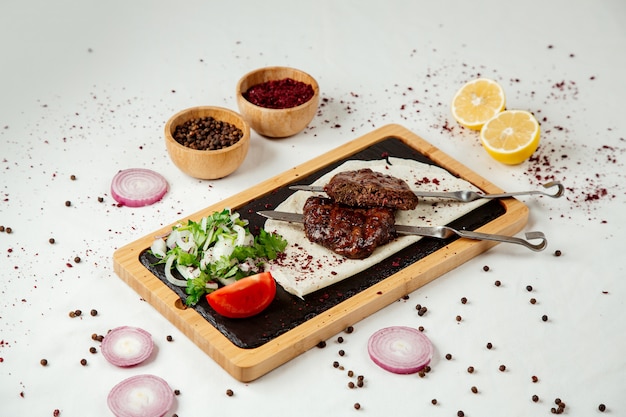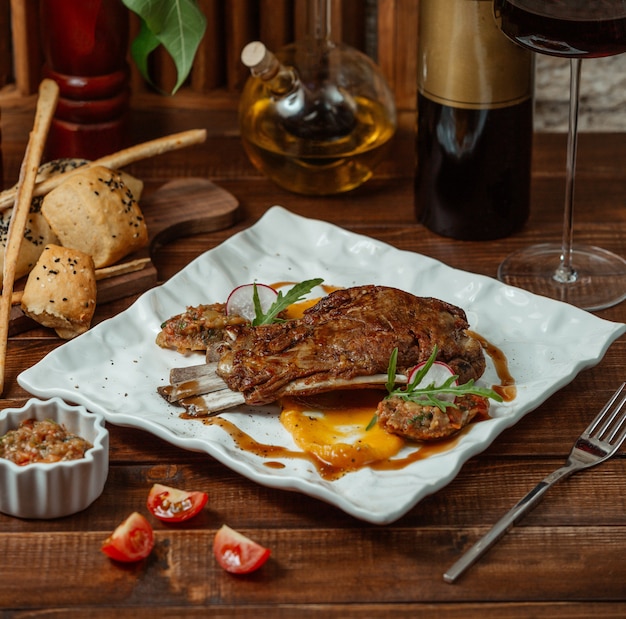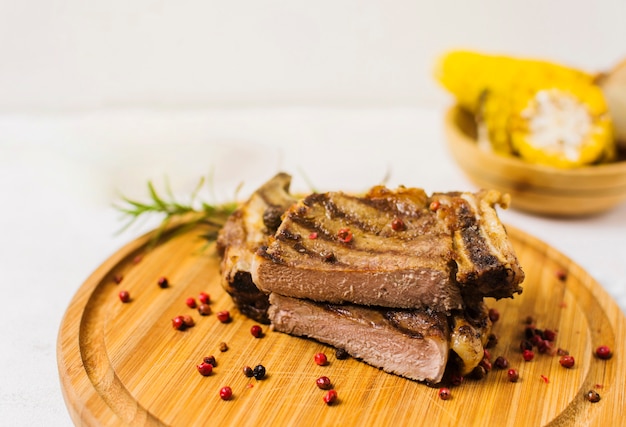Let's be honest, folks, there's something about a perfectly cooked filet mignon that just screams "celebration." It's the ultimate in luxurious dining, a tender, melt-in-your-mouth experience that elevates any meal. But getting that perfect sear, that juicy pink centre, and that incredible flavour isn't always easy. You've probably had your fair share of disappointments, those dry, tough steaks that leave you wondering what went wrong. Well, fret no more! I've been grilling and roasting for years, and after countless experiments and a few burnt offerings (don't ask!), I've finally cracked the code to consistently perfect filet mignon. Get ready to ditch the takeout menus and embrace your inner chef with this comprehensive guide.
(Part 1) choosing the right cut: A Foundation of Flavor

It's All About the Beef: Unlocking the Tenderloin
You can't expect a culinary masterpiece without the right ingredients. When it comes to filet mignon, we're talking about the tenderloin, a muscle that works less than others, resulting in its unparalleled tenderness. But even within the tenderloin, there are variations. For the ultimate experience, seek out a cut from the centre of the tenderloin, often called "centre cut". It's the most tender and lean, giving you that melt-in-your-mouth texture we all crave.
Size Matters: Finding the Right Balance
Now, you don't want a filet mignon that's too small and shrinks to nothing on the grill, nor one that's so thick it takes forever to cook. For a balanced cook and a good sear, aim for a filet mignon that's around 1-1.5 inches thick. This size allows for a beautiful crust while ensuring the inside stays juicy.
The Marbling Magic: Unveiling Flavour
Remember, fat equals flavour, and it's the marbling that really makes a difference. Marbling refers to those streaks of fat running through the meat, a sign of a rich, flavourful experience. When cooked, this fat melts, adding moisture, buttery flavour, and that melt-in-your-mouth texture we love. Look for a "select" or "choice" grade, which indicates a good level of marbling.
Don't Be Afraid to Ask: The Power of Your Butcher
Don't hesitate to ask your butcher for advice. These folks are experts in their field and are happy to guide you. You can even ask them to trim the fat off for you, saving you a bit of prep work later.
(Part 2) Preparing the Filet Mignon: Unleashing the Potential

A Kitchen Arsenal: Gather Your Tools
Now that you have your chosen cut, let's assemble our culinary arsenal. Here's what you'll need:
A Sharp Knife: Precision is key, and a sharp knife will ensure clean cuts and prevent you from crushing the meat.
A Cutting Board: It's time to say goodbye to countertop carnage. A cutting board keeps things clean and provides a stable surface for your prep work.
A meat thermometer: Your trusty gauge for ensuring perfectly cooked steak. This little gadget is your best friend when it comes to achieving the right level of doneness.
Seasoning Powerhouse: Salt, pepper, and your favourite spices are your flavour arsenal.
Trimming the Fat: A Balance of Flavor and Texture
We're not aiming for a lean, dry steak. A thin layer of fat is essential for preventing the meat from drying out, adding flavour, and ensuring a juicy result. However, remove any large chunks of fat that will just render down and burn, leaving you with a bitter aftertaste.
Seasoning Like a Pro: Beyond Basic Salt and Pepper
It's time to elevate your seasoning game. Here's where I share my secret weapon: salt. Season your filet mignon liberally with salt about 30 minutes before cooking. This draws out moisture, which then re-absorbs back into the meat, resulting in a more flavourful and juicy steak. Add freshly ground black pepper and feel free to experiment with other spices, like garlic powder, onion powder, or a pinch of smoked paprika for a deeper flavour.
(Part 3) Cooking the Filet Mignon: Grilling vs. Roasting

The Great Debate: Fire and Oven
Now, the big decision: grill or roast? I'm a confessed grill enthusiast, but both methods can deliver fantastic results. It truly boils down to personal preference and what you have at your disposal.
Grilling for that Crispy Crust: The Sizzle of Perfection
For the grill master, preheat your grill to high heat (about 500°F). This intense heat creates a beautiful, crispy crust and cooks the steak quickly, ensuring a juicy interior. Place your filet mignon on the grill and cook for about 2-3 minutes per side, flipping once to achieve even browning.
Time for the Indirect Heat: A Gentle Finish
After the initial sear, it's time to shift gears. Move the steak to the indirect heat side of the grill (or reduce the heat to medium), allowing it to cook through evenly without overcooking. If you're lucky enough to have a gas grill, you can use a dedicated "sear zone" for that initial sear and then move the steak to a lower heat zone for finishing. For an extra touch of smoky flavour, add a few pieces of wood to the grill (hickory, pecan, or applewood work wonderfully).
Roasting for a More Even Cook: Oven-Baked Excellence
For those who prefer a more even cook, preheat your oven to 400°F. Place your filet mignon on a baking sheet and cook for about 10-12 minutes per side, depending on the thickness of your steak. You can also add a few sprigs of rosemary or thyme to the baking sheet for additional aroma.
(Part 4) Checking for Doneness: The Art of TemperatureTemperature Tells the Tale: The Key to Perfect Doneness
Remember, you can't always trust your eyes alone. To achieve the perfect level of doneness, a meat thermometer is your trusty companion. Here's a handy table to guide your culinary journey:
| Doneness | internal temperature (°F) |
|---|---|
| Rare | 125-130 |
| Medium-Rare | 130-135 |
| Medium | 135-140 |
| Medium-Well | 140-145 |
| Well-Done | 145-150 |
The Finger Test: A Time-Honored Technique
For the brave souls who prefer a hands-on approach, there's always the classic finger test. Press your finger against your palm, then press it against the steak. If the steak feels as firm as your palm, it's rare. If it feels firmer, it's medium-rare. And if it feels the same as the tip of your thumb, it's medium.
Don't Overdo It: Embrace the Pink
Remember, filet mignon is best enjoyed slightly undercooked. The residual heat will continue to cook the steak after it's removed from the heat source.
(Part 5) Resting the Steak: The Art of Patience
The Power of Patience: Letting the Juices Redistribute
This is a crucial step that many people overlook. After you take your steak off the grill or out of the oven, let it rest for about 10 minutes before slicing it. This allows the juices to redistribute throughout the steak, resulting in a more tender and flavourful experience.
Wrap It Up Tightly: Keeping the Warmth In
While the steak rests, cover it with aluminum foil to keep it warm and prevent it from drying out.
(Part 6) Serving Up Your Masterpiece: The Grand Finale
Slicing Like a Pro: A Culinary Dance
The moment of truth! You've put in the work, now it's time to enjoy your culinary masterpiece. Slice the filet mignon against the grain to break down the muscle fibres, resulting in a tender and succulent bite.
Elevate Your Plate: The Art of Accompaniments
For the perfect pairing, serve your filet mignon with a simple side of roasted vegetables, like asparagus, Brussels sprouts, or carrots, or a fresh green salad with a light vinaigrette. Don't forget to add a dollop of softened butter for that rich, buttery flavour and a splash of red wine sauce for a touch of decadence.
(Part 7) Exploring Flavors: Beyond the Basics
Spicing Things Up: A Flavorful Journey
You've mastered the basics, now let's explore some flavourful possibilities! Don't be afraid to experiment with seasonings, using fresh herbs like thyme, rosemary, or oregano, or a sprinkle of cayenne pepper for a kick of heat.
Sweet and Savory: A Symphony of Flavors
For a truly decadent experience, try glazing your filet mignon with a sweet and savory sauce. A balsamic glaze or a maple syrup glaze creates a beautiful contrast of sweet and savoury flavours.
The Art of Marinade: Infusing with Flavor
Marinating your filet mignon for a few hours before cooking is a great way to infuse it with flavour. A simple marinade of olive oil, garlic, and lemon juice adds a bright and refreshing element.
(Part 8) FAQs: Your Culinary Guide
1. What's the Best Way to Reheat Filet Mignon?
To reheat leftover filet mignon, you can use a preheated oven or a skillet. Heat it gently to avoid drying out.
2. Can I Freeze Filet Mignon?
It's best to freeze filet mignon before cooking. Wrap it tightly in plastic wrap and place it in a freezer bag.
3. How Long Does Filet Mignon Last in the Fridge?
Uncooked filet mignon can last in the fridge for 3-5 days. Once it's cooked, it's best to eat it within 3-4 days.
4. What Wine Goes Best with Filet Mignon?
A full-bodied red wine like Cabernet Sauvignon or Merlot pairs beautifully with the richness of filet mignon.
5. What are Some Other steak cuts to Try?
If you're looking to expand your steak horizons, explore a new york strip or a ribeye. These cuts are also known for their flavour and tenderness.
Conclusion: Embrace Your Inner Chef
There you have it, folks! The ultimate guide to cooking a perfect filet mignon, from selecting the cut to achieving that perfect level of doneness and creating a flavourful masterpiece. Now, go forth and embrace your inner chef! With a little practice and these tips, you'll be turning out steaks that will impress even the most discerning foodie. So, the next time you're craving a luxurious meal, remember this guide, and get ready to celebrate with a juicy, tender, and perfectly cooked filet mignon.
Everyone is watching

How to Cook Frozen Lobster Tails Perfectly: A Step-by-Step Guide
RecipesLobster. Just the word conjures up images of lavish meals, special occasions, and a taste of luxury. But let's...

Pork Fillet Cooking Time: How Long to Cook It Perfectly
RecipesPork fillet, or tenderloin as it's sometimes called, is a real favourite in our house. It's so versatile, and...

Pigs in a Blanket Cooking Time: How Long to Bake for Perfect Results
RecipesAh, pigs in a blanket. Just the name conjures up images of those delightful little parcels of crispy pastry en...

The Ultimate Guide to Cooking Delicious Frankfurters
RecipesLet's face it, we all love a good frankfurter. It's a classic, simple, and always satisfying. But let's be rea...

Wolf Meat Recipes: A Guide to Cooking Wild Game
RecipesLet's be honest, you don't see wolf meat at your local butcher shop every day. It's a bit of a wild card, but ...
